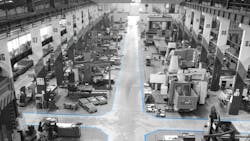If you run a family-owned manufacturing business and you’ve got a long, successful history of making products that your customers want, things are good.
But your newest competitors have the benefit of new technologies and capabilities out of the gate. They have the benefit of starting with a blank slate in how to approach customer acquisition, target markets, and attracting talent, without the burden of outdated processes and systems holding them back.
To maintain your competitive edge, you’ll have to find ways of making what you already make, at the same or better quality, but faster and more profitably.
That’s a tall order. Thanks to incessant customer demands, products are becoming more complex than ever—and so is the global supply chain.
So, you’ll need to make more informed decisions than ever about your supply chain, and about how changes in customer demand affects production.
This means you can’t afford to wait for a quarterly meeting—or even a weekly report—to change direction. You need real-time information from all points along your supply chain and production line. Your company needs to monitor all of these elements even as you sleep.
It’s time to embrace the Industrial Internet of Things (IIoT).
Embrace IIoT, or Become Obsolete?
You’ve probably heard the buzz about IIoT. Your peers who have embraced IIoT are already using sensors, machine-to-machine (M2M) communication, and mobile devices—a network of physical objects on the shop floor—to gather real-time data on their manufacturing processes.
These always-connected “things” and systems work together to leverage data from one part of the business to enhance others. For example, data about the efficiency of a production line machine could be used in a report about project maintenance and repair expenses for the upcoming quarter. Or, a warehouse clerk’s visual inspection of inventory levels might send data from his smart glasses or mobile device to the purchasing department, who will generate a PO for another shipment of raw materials.
You can imagine how IIoT could help you foster a data-driven approach to running your manufacturing business. With IIoT technology, you can closely monitor your supply chain and pinpoint the location of any item within it. You can keep track of works-in-progress (WIP) inventory so that you’ll know what you can reasonably promise a customer. You can monitor raw material usage so that you’re never surprised by a stockout.
IIoT generates massive amounts of data, and most of it can be useful to your business if you just find the right place for it. By mining, analyzing, and acting on the data generated by people, things, and computers, you can identify inefficiencies you didn’t even know you had.
But there’s a catch: if you’re still using a legacy ERP system or relying on manual processes, you’ll be unable to access and manipulate this data quickly enough to make a difference. You won’t be as efficient or as flexible as your IIoT-enabled competitors.
Jump-Start Your IIoT Journey with Cloud ERP
Outdated legacy ERP systems aren’t exactly known for their flexibility, computing power, and ability to talk to other systems. By their very nature, they perpetuate the age-old problem of data siloes.
A cloud ERP system is different. Extreme connectivity and flexibility makes this system an ideal hub for all your business management, production systems, and connected devices. Cloud ERP gives you a single source of truth—a highly available “hub” through which to eavesdrop on all the machine-to-machine communication.
As new competitors spring up around the globe and you search for ways to do what they do—only better, and at a lower cost—consider shifting your focus.
You know by now that disconnected, manual-based shop floor processes slow you down and hinder your competitiveness. You’ve probably considered replacing old equipment, reconfiguring your production processes, and implementing new software as ways of addressing these challenges.
Your instincts are good—but you want to make the right investment. A cloud ERP system helps you set the foundation for the future while helping you meet the challenges you have right now. So you can keep your family legacy alive and well.
Read more by downloading the white paper: How Cloud ERP Turns IIoT into a Critical Success Strategy for Manufacturing.
